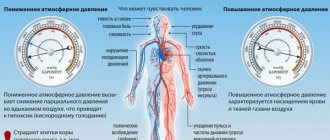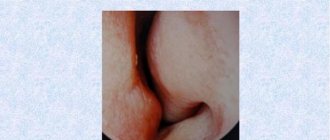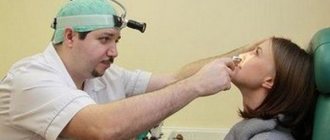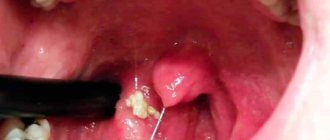Causes of sinusitis
Sinusitis is an inflammatory disease that cannot have a hidden course and manifests itself quite early. What symptoms indicate the development of a pathological process?
- A feeling of fullness appears and intensifies in the right or left half of the face near the nose; in severe cases, a bilateral process is possible. Tilt of the head increases the feeling of pressure and causes pain.
- Congestion accompanied by nasal discharge. the nature of the mucus (thick exudate of a greenish or yellow tint, with a runny nose, liquid transparent snot). If the mucus is very thick and the duct of the maxillary sinus is blocked, there may be no discharge.
- Severe pain in the maxillary sinus during an acute process can be reduced during a chronic course. In any case, a severe headache occurs.
- Syndrome of general intoxication of the body: high body temperature, thirst, chills, weakness, lethargy, lack of appetite and drowsiness.
Only acute sinusitis has a clear manifestation; with a chronic process, all signs can be reduced. Constant headaches that are difficult to treat and a feeling of nasal congestion come to the fore.
There are quite a few factors that cause inflammation of the maxillary sinus. They are divided into several categories and differ in certain features.
Infections
Sinusitis is often a consequence of influenza, rubella, measles and other viral pathologies that were not promptly cured. The following factors lead to the appearance of pathology:
- against the background of the underlying disease, inflammation and swelling of the mucous membrane is observed;
- congestion occurs;
- the passage to the sinuses narrows and then closes completely;
- secretion removal is impaired;
- abnormal fluid accumulates in the sinuses.
During this period, manifestations of viral pathology may completely disappear, and the person seems to feel better. In this case, purulent contents gradually fill the sinus. That is why, after a certain time, manifestations of sinusitis occur.
Dental diseases
This inflammation is caused by the spread of bacterial microorganisms from diseased teeth into the maxillary sinuses. The following disorders can lead to the appearance of a pathological process:
- osteomyelitis;
- advanced forms of caries;
- maxillary cyst;
- periodontitis.
Mechanical injuries and deformations of the nasal septum can provoke the outflow of secretions and lead to subsequent blockage of the sinuses. This causes sinusitis.
In this case, the problem is caused by a violation of the structure of the ciliated epithelium. With this form of the disease, thinning of the mucous membranes is observed, which leads to loss of their functions.
They do not clean or warm the inhaled air. In addition, the mucous membranes are not able to remove harmful microorganisms from the nose and synthesize secretions. This is precisely what atrophy of the membranes consists of. Most often, this problem occurs with frequent and prolonged infections.
Why does sinusitis occur without a runny nose?
Infections . If influenza, rubella, acute respiratory viral infections and other viral diseases are not treated in time, complications can develop. Even improper treatment leads to a worsening of the situation. It is enough to endure a severe cold on your feet. Everything happens as follows: during the main illness, the mucous membrane swells; nasal congestion appears; the passage to the maxillary sinuses narrows or is completely blocked; there are disturbances in the outflow of secretions; mucus accumulates in the sinuses.
At the same time, the symptoms of the underlying viral disease begin to disappear. The person feels better and thinks he is getting better. And the pus gradually accumulates and fills the entire sinus completely.
Dental diseases . If diseased teeth are not treated promptly, the infection will begin to spread from the tooth to the maxillary sinus. The disease is caused by: periodontitis; untreated or severely advanced caries; cysts of the upper jaw.
Toothache with sinusitis
However, the symptoms may not be immediately noticeable.
Injuries, damage . Deformation of the nasal septum leads to blockage of the sinus and impaired outflow of secretions. Sinusitis develops without a runny nose. Atrophic course of the disease.
If there is no snot with sinusitis, it means that the ciliated epithelium has been damaged. In such a situation, the mucous membrane becomes thin and loses its functions. It cannot clean the inhaled air, cannot warm it, and does not produce mucus. The shell cannot fight pathogenic bacteria. This condition does not just appear; it requires long-term, protracted inflammation and persistent infectious diseases.
About the disease
Pain in is a clear sign of the development of maxillary sinusitis (sinusitis). Due to the structural features of the paranasal sinuses, the viscous secretion formed as a result of the disease is not evacuated from the nasopharynx, but stagnates inside the air cavities. The cause of pathological processes in the mucous membrane of the ENT organs can be:
- microbial, viral or fungal infection;
- allergic runny nose or hay fever;
- deviated nasal septum;
- benign tumors in the nasopharynx (polyps);
- swelling of the anastomosis of the maxillary sinus.
Quite often, sinusitis without rhinitis (runny nose) develops against the background of other respiratory diseases: ARVI, scarlet fever, influenza, vasomotor rhinitis, etc. If diseases are not treated in a timely manner, inflammatory processes involve, in particular, the maxillary. People develop sinusitis mainly due to decreased local immunity.
Important! Late diagnosis of maxillary sinusitis is fraught with breakthrough of the abscess and infection of the meninges, which leads to meningitis or rhinogenic sepsis.
Diseases
Pain under the eye, in the facial bone - this means purulent inflammation or a problem with neuralgia. It all depends on the nature of the pain, its location and how it manifests itself: when pressed or simply exists.
The appearance of an inflammatory process in the sinuses provokes pain under the eyes. Inflammation is caused by bacteria and viruses. Staphylococcus aureus is especially dangerous. It develops when the respiratory tract becomes infected or the patient has advanced dental problems: deep caries, periodontitis.
Patients at risk may develop sinusitis:
- The nasal septum is bent.
- There are congenital defects in the structure of the nasal cavities.
- Nose injuries.
What can cause an inflammatory process in the nasal cavity:
- Allergy. A disease that affects more and more people every year. Allergens include: dust, wool, pollen, household chemicals, fluff, food.
- Deformed sinus. As a result of mechanical damage, a curvature of the nasal septum, displacement of the jaw, and improper fusion of the skull bones occur. Congenital abnormal structure of the nasal concha.
- Viruses. When viruses penetrate the nasal sinuses, fluid is released, the channels narrow, and swelling appears. The appearance of additional bacteria leads to non-response to antibiotic treatment.
- Fungi settle in the sinuses, causing them to become clogged. A disease occurs - mycosis. Different types of fungus cause different severity of the disease.
- Cold air. The reaction of blood vessels to a decrease in ambient temperature is narrowing. As a result, less oxygen reaches the eyes. There is pain under the eye. Airborne dust and gas particles cause pain around the eyes.
- Avitaminosis. A lack of vitamins in the body leads to a decrease in protective functions. This is why colds occur so often in winter and spring. The body cannot resist the infection, a runny nose occurs and, subsequently, complications.
- Hypothermia. Hypothermia leads to a decrease in protective function. Infections attack organs that cannot resist for long - breathing. With a constant cold, a person's nose becomes clogged and rhinitis occurs, which will worsen in the fall and winter, when it is cold.
Main symptoms
When sinusitis develops, a person experiences a number of manifestations:
- Pressure in the area of the bridge of the nose. This symptom increases when the head is tilted forward.
- Pain in the nose area. It may spread to other areas of the face. When chewing and talking, the pain may increase. The sinus pain is especially severe in the morning and after a long stay in one position. By evening, the discomfort decreases slightly.
- Increased temperature, chills. Usually it does not exceed 37.8 degrees. At the same time, the body often aches. The increase in temperature is due to the prolonged presence of inflammation. However, sometimes the indicators remain normal.
- Headache. This symptom usually increases with changes in head position. In a horizontal position, the pain most often becomes stronger.
- Swelling of the cheeks. Swelling can affect the cheeks, face, eyelids.
In addition to the main symptoms, additional manifestations often occur. These include the following:
- severe nasal congestion – observed in all types of sinusitis;
- sleep disturbance – caused by general malaise;
- severe fatigue, weakness;
- loss of performance – due to malaise;
- loss of appetite;
- Photophobia is caused by the action of harmful microorganisms on the optic nerves.
Symptoms accompanying sinusitis without runny nose and congestion
“Dry sinusitis” is characterized by the following symptoms:
An increase in body temperature that lasts for several days. The patient may feel chills. In some cases, the temperature may remain at normal levels; this may be due to weak immunity, taking antibiotics or antipyretics. Pressure in the bridge of the nose. The sensation intensifies when the head is tilted forward. Pain in the nasal area. Gradually their localization expands and pain is felt in other areas of the face. Chewing, talking, changing head position increase the pain syndrome. Discomfort is especially pronounced in the morning; as a rule, in the evening all manifestations subside. Swelling. Swelling is typical in the cheeks, eyelids and other parts of the face. Decreased performance, concentration, appetite, general malaise, fatigue, insomnia.
This is what the symptoms of sinusitis look like without a runny nose
The occurrence of sinusitis without a runny nose, discharge and congestion from the nasal passages in children is characterized by the following symptoms:
discomfort in the nasal cavity, which intensifies in the evening; pain in the gums or ears; bad breath; loss of hearing acuity; constant fatigue.
Knowing the symptoms and possible causes of this pathology, you can independently suspect the disease in yourself or your child. At the first doubt, it is recommended to consult a specialist to make an accurate diagnosis. Proper and timely treatment and adherence to recommendations are the key to success!
Treatment Methods for Sinus Pain
Many people are interested in how to relieve pain and cope with the inflammatory process. With the development of pathology, the maxillary sinus can significantly increase in size. This is due to viral diseases, allergies, and hypothermia.
To cope with swelling, antihistamines are used. The most effective drugs include cetrin. Washing the nose is of no small importance. This procedure is recommended to be carried out in medical institutions.
An article on the topic - what antibiotics treat sinusitis.
Non-surgical treatment is carried out by chemical, biological and physical methods. Conservative therapy has two main goals: the destruction of infection in the maxillary sinuses and the elimination of inflammatory processes in the mucous membranes. As a rule, the treatment regimen for respiratory diseases includes:
- medications – stop the main manifestations of the disease and destroy pathogens;
- physiotherapeutic procedures – stimulate regeneration processes in tissues and increase local immunity (laser therapy, radiotherapy, UHF therapy).
Only a qualified specialist can correctly draw up a treatment regimen after identifying the causative agent of the infection. It should be understood that sinusitis can be provoked not only by bacteria or viruses, but also by allergic agents. In all cases, the principles of treatment will have significant differences.
A surgical operation is performed to pump out purulent masses from the maxillary cavity. Surgical intervention is resorted to only if drug and physiotherapeutic treatment is ineffective. Until recently, puncture of the maxillary sinus was the only possible way to quickly remove pus from the air cavities.
Today, there are more gentle, minimally invasive procedures that can be used to painlessly remove pathological secretions from the affected paranasal sinuses. They are used for women during pregnancy. Sanitation of ENT organs takes no more than 30-40 minutes, so treatment is often carried out on an outpatient basis.
Systemic treatment
Antibiotics
Antimicrobials are used to treat bacterial infections. Systemic antibiotics destroy microbes not only in areas of inflammation, but throughout the body. This allows you to prevent the spread of infection and stop inflammation in the maxillary cavity. Often used to treat bacterial infections in the paranasal sinuses:
- penicillins - “Unazin”, “Panklav”, “Amoxiclav”;
- macrolides – Clarithromycin, Azithromycin, Dirithromycin;
- cephalosporins - Cemidexor, Ceftriaxone, Suprax;
- fluoroquinolones – “Moxifloxacin”, “Ciprofloxacin”, “Levofloxacin”.
Penicillins often cause allergic reactions, so they are usually replaced with cephalosporin or macrolide antibiotics.
Antimycotics (antifungal agents) are used to destroy mycotic, i.e. fungal flora in the respiratory tract. Very often develops due to the irrational use of local antibiotics - Isofra, Bioparox, etc. Abuse of antimicrobial agents leads to a decrease in local immunity, which creates optimal conditions for the proliferation of opportunistic fungi of the genus Candida. Typically, the following drugs are used to treat fungal sinusitis:
- "Ketoconazole";
- "Amphotericin B";
- "Itraconazole"
If fungal flora develops, the maxillary sinus does not always hurt. For this reason, the disease most often develops practically asymptomatically. Delayed treatment of mycoses leads to tissue necrosis inside the air spaces, which is a direct indication for surgery.
An unpleasant smell from the nose, difficulty breathing through the nose and a feeling of fullness of the maxillary sinuses from the inside are the key manifestations of fungal sinusitis.
Antiviral medications are prescribed if maxillary sinusitis occurs due to the development of a viral infection in the respiratory tract. As a rule, the disease develops against the background of acute rhinitis, influenza, herpes and other respiratory diseases. Foci of inflammation in the paranasal sinuses can be eliminated using the following drugs:
- "Oseltamivir";
- "Remantadine";
- "Amantadine."
In rare cases, sinusitis occurs due to the spread of a herpes infection within the airways. In this case, inflammation can be stopped by taking Valaciclovir or Acyclovir-Acri."
Treatment
Many people do not pay enough attention to sinusitis and consider it frivolous. There is no need to think that everything will go away on its own. If left untreated, you may encounter more serious consequences: the spread of infection to the membranes of the brain, the appearance of meningitis, and sepsis.
Treatment is carried out in two ways:
surgical method; conservative option.
The first method is rarely used. It is used in situations where conservative treatment has not helped and the disease progresses. Surgeon intervention is also required when polyps or formations are found in the paranasal sinuses or nasal cavity.
Conservative technique includes:
fever-reducing medications. Prescribed at high temperatures. Must be in bed; for severe headaches, painful sensations in the ears - painkillers; for symptoms of intoxication, antimicrobial agents are prescribed; if allergic reactions occur, antihistamines are prescribed.
Medicines for sinusitis
The cause of the disease may be a deviated nasal septum or severe caries. In this case, it is these phenomena that need to be eliminated. Medicines are needed that improve the outflow of fluid from the maxillary sinus, reduce swelling and improve well-being.
In some cases, traditional medicine can help, but they should not be taken without consulting a doctor. It is necessary to treat sinusitis comprehensively; medicinal herbs alone cannot do it.
Medicines
If inflammation appears in the maxillary sinuses, treatment should begin immediately. If you do not start therapy on time, there is a risk of swelling and clogging of the holes. This will lead to an accumulation of pus.
First of all, the patient must restore breathing and eliminate swelling. For this purpose, drops of otilin or Nazivin are used. The product must be used in accordance with the instructions. This must be done for no more than 5 days. Thanks to such substances, it will be possible to quickly cope with the manifestations of inflammation.
If intolerance to these drugs is observed, tetracycline is used.
To eliminate pain, non-steroidal anti-inflammatory drugs are used. They quickly relieve discomfort and improve the patient’s condition. Minor pain can be eliminated with paracetamol and analgin. In addition, these drugs reduce body temperature.
For more severe pain, the use of ketanov or ketolong is usually recommended. These substances have a pronounced analgesic effect. In addition, they have moderate antipyretic and anti-inflammatory properties. Such medications should be taken once or for constant pain. Do not exceed the daily dosage, which is 40 mg.
Additional symptoms
- difficulty breathing due to nasal congestion;
- mucous discharge from the nose , which, depending on the form of rhinitis and severity, may differ in consistency and composition (including containing particles of blood and pus);
- complete or partial (but temporary) loss of smell due to the effect of swollen tissue on the olfactory receptors;
- increase in body temperature within 1-3 degrees;
- headaches that occur when the trigeminal nerve is compressed by swollen tissues in the frontal sinuses;
- general weakness and fatigue during the day;
- loss of appetite.
Swelling can develop not only in the nose area. The tonsils, palate and tongue may become swollen.
Local treatment
Medicines for intranasal administration help reduce inflammation in the anastomosis of the maxillary sinuses. Thus, the patency of the airways increases, as a result of which the outflow of mucus from the maxillary cavities improves. This prevents the abscess from breaking through and the development of inflammation in the membranes of the brain.
Abuse of hormonal drugs leads to allergic reactions and the development of medicinal rhinitis.
Corticosteroids quickly stop inflammation and relieve swelling of the mucous membranes. However, they can only be used as prescribed by a doctor in the dosage recommended by him.
Sanitation of the nasal cavity allows you to quickly cleanse the mucous membrane of viscous secretions and eliminate swelling. It is advisable to use antiseptics and preparations based on sea salt as preparations for rinsing the nasopharynx. The former destroy the infection in areas of inflammation, and the latter dilute and remove pathological secretions from the paranasal sinuses. The most effective means for irrigating the nasal cavity include:
- "Chlorophyllipt";
- "Chlorhexidine";
- "Dolphin"
- "Physiomer";
- "Furacilin".
Physiotherapeutic procedures should be performed at least 3-4 times a day during the period of exacerbation of the disease. Regular sanitation of the airways helps strengthen local immunity and reduce swelling in soft tissues. In addition, isotonic solutions prevent drying out of the mucous membrane and the development of atrophic rhinitis.
Sinus rinsing
If a large amount of secretion is produced, it must be removed by rinsing. However, sometimes hard crusts form in the sinuses. In such a situation, there is a risk of accumulation of a large number of bacteria.
Subsequently, they fill the entire sinus cavity, which leads to intense headaches. A person may experience hearing loss, decreased vision and sense of smell. In particularly difficult situations, memory loss even occurs.
In this case, it is necessary to select complex therapy, which includes several stages:
- To begin with, warm up the head. For this purpose, water procedures are used. This helps to liquefy the purulent secretion.
- The pus is then removed by rinsing the sinuses. Various methods can be used for this. The simplest and most common way is to use sea salt. You can also use ready-made preparations - aquamaris, marimer, aqualor.
To carry out the procedure, you should equip yourself with a special syringe without a needle. A polyethylene tube is placed over it, which is then inserted into the nose. The head should be tilted over the sink. At this point, the doctor places a tube into the sinus and gently injects fluid. The procedure must be carried out within 5 days.
Article on the topic - how to rinse your nose with sinusitis.
Causes of pain in the sinuses
One of the main causes of pain is the impact of some negative factor on the nasal mucosa. As a result, inflammatory processes of varying intensity begin to develop on its surface. In medical terminology, this reaction is called “rhinitis.” Here is a list of its main types:
- Infectious.
- Allergic.
- Medication.
- Vasomotor.
- Hypertrophic.
- Atrophic.
- Specific.
Rhinitis of infectious etiology develops due to exposure to various bacteria, viruses, and fungi on the mucous membrane. The pain syndrome in this case is the result of swelling of the mucous membrane. In the absence of adequate treatment, the pathological process quite quickly passes into the exudation phase, the main symptom of which is the appearance of a runny nose. In this case, nasal discharge is transparent in most cases. With a staphylococcal infection, they can acquire a greenish tint.
Allergic rhinitis is manifested by copious discharge from the nasal cavity, frequent sneezing, lacrimation, and congestion of the nasal passages. In addition, a person has pain in the sinuses and head, and the pain is constant, the duration of which depends on the period of time of interaction with a specific allergen.
Vasomotor or vascular rhinitis. This is a pathology that occurs in the human body without exposure to any provoking agent. The disease is a consequence of vasospasm of the mucous membrane of the nasal cavity against the background of its special sensitivity to the effects of low temperatures. Therefore, the first manifestation of the disease usually occurs in winter.
Rhinitis of infectious etiology develops due to exposure to various bacteria, viruses, and fungi on the mucous membrane. The pain syndrome in this case is the result of swelling of the mucous membrane. In the absence of adequate treatment, the pathological process quite quickly passes into the exudation phase, the main symptom of which is the appearance of a runny nose. In this case, nasal discharge is transparent in most cases. With a staphylococcal infection, they can acquire a greenish tint.
Allergic rhinitis is manifested by copious discharge from the nasal cavity, frequent sneezing, lacrimation, and congestion of the nasal passages. In addition, a person has pain in the sinuses and head, and the pain is constant, the duration of which depends on the period of time of interaction with a specific allergen.
Vasomotor or vascular rhinitis. This is a pathology that occurs in the human body without exposure to any provoking agent. The disease is a consequence of vasospasm of the mucous membrane of the nasal cavity against the background of its special sensitivity to the effects of low temperatures. Therefore, the first manifestation of the disease usually occurs in winter.
It is because of this feature that the pathology is sometimes called “cold allergy.” Due to disturbances in the vascular system, the disease continues to actively manifest itself in warm climates. Its main symptoms include severe pain in the bridge of the nose and liquid discharge from its channels, the basis of which is sweated blood plasma.
Hypertrophic rhinitis is a chronic pathology characterized by severe proliferation of the mucous membranes of the nasal canals. The result of this process is a narrowing of the nasal passages. This leads to changes in voice and constant soreness in the sinus area.
Atrophic rhinitis is the opposite of the previous process, the result of which is atrophy of the mucous membranes of the nose and paranasal sinuses. This leads to the fact that the glandular cellular structures lose their ability to absorb exudate, which causes a runny nose and permanent pain.
Specific rhinitis occurs as a result of exposure of the mucous membranes to dangerous bacteria. These include the causative agents of leprosy, syphilis, and tuberculosis. As a result of such destructive processes, not only the mucous membranes are destroyed, but also the bone structures adjacent to them. Due to damage to the nerve endings, the sinuses hurt, and the pain syndrome occurs at the very last stages of the pathological process.
Drug-induced rhinitis develops against the background of prolonged use of medications that have a vasoconstrictor effect on the mucous membranes. Typically, such drugs are remedies for the common cold, an attempt to cure which leads to the exact opposite result. Pathological narrowing of blood vessels causes persistent disruption of blood supply and the development of drug-induced rhinitis.
One of the most common diseases that causes constant pain in this area. The pathology is very often accompanied by profuse lacrimation. The lack of therapeutic measures leads to a narrowing of the nasal cavity and causes manifestations of chronic rhinitis, which is not amenable to any medication. Symptoms of the disease disappear only after puncturing the maxillary sinuses and pumping out the contents accumulated there.
The main signs of sinusitis, in addition to discomfort, include:
- feeling of tension and pressure in the affected area;
- pain in the cheekbones, temples, forehead;
- difficulty with nasal breathing;
- temperature increase;
- general malaise.
Pain without runny nose
Constant pain in the sinuses without a runny nose can have the following causes:
- Traumatic injuries.
- Facial burns.
- Inflammatory skin diseases.
- Herpetic infection.
- Acne.
- Neurological pathologies.
To clarify the diagnosis, you must contact qualified medical specialists.
Diagnostics
Establishing the true cause of the problem is possible only in a specialized medical institution. If the pain syndrome is accompanied by active manifestations of a runny nose, then there is a high probability that this pathological process is in the wake of diseases of the otolaryngeal spectrum. And the best option would be to consult an otolaryngologist.
If painful sensations in the paranasal sinuses are not accompanied by discharge from the nasal canals, and the person does not have any dermatological manifestations or lesions of the facial part, then the best choice would be to consult a neurologist. In this case, most likely, the process is neurological in origin and may indicate trigeminal neuralgia.
Sinuses hurt without a runny nose: what to do and how to treat?
If you have sinus pain, there is reason to take a serious look at your health. This pain indicates the presence of a respiratory tract infection or benign growth.
Self-medication in such situations is fraught with serious complications; the only correct solution is to visit a qualified doctor. After an endoscopic examination, the specialist will accurately determine the causes of pain, prescribe complex treatment, and, if necessary, puncture the inflammatory paranatal sinuses (maxillary sinuses, frontal sinuses).
Why does pain occur?
The nasal and paranatal sinuses of the epididymis are covered with mucous membrane. First, inflammation of the nasal mucosa. Inflammation is accompanied by burning and pain in the nasal area.
In the absence of treatment or improper use of medications and traditional medicine recipes, the inflammation spreads further, affecting the sinuses.
Pain occurs in the bridge of the nose, frontal arches and can spread to the back of the head.
The examination may reveal inflammation of one or more appendages. According to statistics, all 12 people who go to a medical facility suffer from inflammation of the maxillary sinus (sinus bleeding). Pain in the nose may cause irritation of the mucous membrane or frontal sinus.
Inhalations
Inhalations will help cope with inflammation in the maxillary sinuses. To carry out the procedure, you can mix 10 drops of propolis tincture and 1 liter of hot water. Then you need to bend over the solution and cover yourself with a towel. Inhale beneficial fumes for 5-10 minutes. It is recommended to carry out the procedure throughout the week.
It is also quite possible to boil some potatoes in their skins. Then inhale the vapors of the medicinal mixture. The procedure should be done in the evenings for 2 weeks.
What to do
If the sinus under the eye hurts, you should seek qualified help at your place of residence as soon as possible. It should be remembered that pain does not occur for no reason, and sinus inflammation does not tend to heal spontaneously.
Painful sensations arise already at the stage of the developed process, when the sinus cavity is clogged with exudate and puts pressure on the nerve fibers, or when there is purulent damage to the membranes of the nose.
What to do if the sinus under the eye hurts before visiting the ENT doctor’s office. Actions to take when detecting only local pain without fever and general intoxication syndrome (onset of illness):
- If you have an inhaler or steam bath for the face at home, you can perform inhalation, which helps soften and liquefy the contents of the sinus cavity. It is recommended to use anti-inflammatory herbal decoctions: chamomile, sage, calendula, mint; or essential oils: eucalyptus, chamomile. Regular mineral water works well.
Important. When carrying out inhalation, do not allow the head to overheat and adhere to the time frame. When using the steam type, rinse your face with cool water and wait for no more than 3 minutes. A portable inhaler allows you to extend the procedure up to 15 minutes without the risk of overheating.
One of the effective methods of steam inhalation is breathing in steam from boiled potatoes. Do not use at fever or presence of purulent discharge.
- After inhalation, rinse the maxillary sinuses, this will reduce pain. You can put anti-inflammatory drops in your nose or use traditional medicine (honey, aloe, celandine).
- For headaches, you can take Ibuprofen, paracetamol, the same drugs will help with high fever.
- Drinking plenty of fluids will reduce intoxication, facilitate the fight against hyperthermia (high temperature) and help thin the exudate in the sinuses, which will facilitate the cleansing process.
If your sinuses hurt, what should you do in this situation? Self-medication may not produce results or lead to the development of various complications. If persistent pain occurs, you should seek qualified help as quickly as possible. It can include a wide range of procedures. This can be either nasal rinsing and drug treatment, or emergency surgery.
Sinus pain in nose.
Answers:
Trojan virus
Frontal sinuses and ethmoiditis (in addition to sinusitis) can also radiate to the frontal sinuses. but an accurate diagnosis can only be made by an ENT specialist and after an x-ray of the sinuses. PY. SY. for general development. The sinuses are not located in the nose, but in the bones of the skull.
Sergey Sukhanov
Losmy
Go to the doctor. When you bend over, the pressure in your sinuses increases (do you feel it?).
similar to sinusitis (sinusitis, dandy (difference in the location of the pus)
Dmitry Tukmachev
Try pouring aloe juice into your nose.
Mikhail Shevaldov
Inflammation, beginning sinusitis.
Roma Sidorov
sinusitis. See a doctor immediately before it’s too late.
Raspberries
You definitely need to take a picture, it looks like sinusitis. Try drinking Sinupret!
EKATERINA SMIRNOVA
Sinusitis is an inflammation of the mucous membrane of the paranasal (paranasal) sinuses (see WHAT YOU NEED TO KNOW ABOUT THE ACCESSORY SINUSES). Sinusitis can be acute, subacute, chronic, allergic and hyperplastic.
What are the causes of sinusitis?
Sinusitis is usually caused by a viral or bacterial infection. Acute sinusitis develops mainly as a consequence of a runny nose; in approximately 10% of cases it becomes subacute. Chronic sinusitis occurs as a result of a difficult to treat bacterial infection.
chronic nasal swelling;
secretion of too thick mucus by the mucous membrane;
allergic inflammation of the mucous membranes of the nose (allergic rhinitis);
weakening of the body after chemotherapy, due to malnutrition, diabetes, blood disease, long-term use of steroid drugs or suppressed immunity.
Bacterial invasion of the paranasal sinuses is usually determined by the factors listed above or follows a viral infection. Swimming in a pool with contaminated water can also lead to the development of a bacterial infection.
Allergic sinusitis often occurs as a complication of allergic rhinitis. Hyperplastic sinusitis is a combination of purulent and allergic inflammation of the paranasal sinuses or purulent sinusitis and allergic rhinitis.
What are the symptoms of the disease?
Symptoms of sinusitis vary and depend on the type of infection.
The main symptom of acute sinusitis is nasal congestion, accompanied by a gradual increase in pressure in the affected paranasal sinus. A runny nose may appear 24-48 hours after the first symptoms appear. Later, pus appears in the nasal discharge. General health worsens, sore throat and head, temperature rises (from 37.2° to 37.5°). The localization of pain depends on which sinuses are inflamed. It can hurt in the cheeks and upper teeth, above the eyes, above the eyebrows and behind the eyes.
In case of subacute inflammation of the paranasal sinuses, after the infection is eliminated, nasal discharge mixed with pus is observed for another 3 weeks. Other symptoms: stuffy nose, general discomfort in the face, fatigue and cough without phlegm.
What you need to know about the paranasal sinuses
Until you had sinus infections, you probably never thought about them. Now you can't think about anything else. Read the information below to understand how your sinuses work, where they are located, and why they cause you so much trouble.
What are the paranasal sinuses used for?
The paranasal sinuses are air spaces in the facial bones of the skull that give shape to the face and serve as vocal resonators.
Where are the paranasal sinuses located?
Four pairs of sinuses—the frontal, maxillary (maxillary), sphenoid, and ethmoid sinuses—are located above and along the nose on both sides of the face.
Why do sinusitis cause severe pain?
Pain occurs when the mucous membrane lining the sinuses becomes inflamed (inflammation is caused by infection or obstruction). Normally, mucus drains into the nose through tiny holes in the bones. If inflammation begins, these openings become blocked, causing the infection to worsen, causing headaches, nasal congestion, and other symptoms. Chronic sinusitis
The symptoms of chronic sinusitis are the same as those of acute sinusitis. However, with chronic sinusitis, mucous discharge mixed with pus is constantly observed.
The main symptoms of this type of inflammation are sneezing, headache in the frontal part of the head, watery discharge, nasal congestion, burning and itching in the nose.
This type of sinus inflammation causes chronic nasal congestion and headaches.
Olga Osipova
You may have sinusitis. And he is treated with tetracycline hydrochloride. This is an antibiotic. But still find time to go to the doctor. Self-medication in this case is dangerous.
Vasta Mawela
Nika16D.
Free as a wind**
Unpleasant sensations appear in the nose and paranasal area, which gradually increase. The pain is less pronounced in the morning and increases in the evening. Gradually, the pain “loses” a certain place and the patient begins to have a headache. If the process is unilateral, then pain is noted on one side. Difficulty in nasal breathing. The patient has a stuffy nose. The voice takes on a nasal tone. As a rule, both halves of the nose are blocked. Difficulty in nasal breathing is constant or with slight relief. Alternate congestion of the right and left halves of the nose is possible. Runny nose. In most cases, the patient experiences mucous (transparent) or purulent (yellow, green) discharge from the nose. This symptom may not exist if the nose is very stuffy, since the outflow from the sinus is difficult (this was mentioned above). Increase in body temperature to 38 and above. As a rule, this symptom is observed in acute sinusitis. In a chronic process, body temperature rarely rises. Malaise. This is expressed by fatigue, weakness, patients refuse food, and their sleep is disturbed.
FRONTITIS is much more severe than inflammation of other paranasal sinuses. With frontal sinusitis, the following symptoms are observed: pain in the forehead, especially in the morning, impaired nasal breathing and discharge from the corresponding half of the nose. The pain is often unbearable and becomes neuralgic in nature. In severe cases, there is pain in the eyes, photophobia and decreased sense of smell. In acute influenza frontal sinusitis, the body temperature is elevated, swelling and swelling in the forehead and upper eyelid are noted, which are a consequence of local circulatory disorders.
SPHENOIDITIS is quite rare. Complaints of headache are common. Most often it is localized in the crown area, deep in the head and back of the head, and in the orbit. With chronic lesions, pain is felt in the crown area, and with large sinuses it can spread to the back of the head. A rapid decrease in vision is possible, which is associated with the involvement of the optic chiasm in the process.
ETHMOIDITIS usually occurs simultaneously with damage to the maxillary and frontal sinuses. There is a headache, pressing pain in the root of the nose and bridge of the nose. Children often experience swelling of the internal parts of the upper and lower eyelids and conjunctival hyperemia on the corresponding side. Characterized by a sharply reduced sense of smell and significantly difficult nasal breathing. Body temperature is usually elevated. If the outflow of pus is obstructed, the inflammatory process can spread to the orbit. In such cases, the eyelids swell and the eyeball deviates or protrudes outward.
These are just the main complaints with sinusitis. The diagnosis is helped by X-ray or computed tomography (a more informative method) of the paranasal sinuses. After this, a qualified otolaryngologist should easily establish a diagnosis and prescribe adequate treatment.
Olga Babkina
GALINKA
Only a doctor can make a diagnosis for you. Urgently see an ENT specialist. Health.
darling
sinusitis started. You can make a puncture, but. . Better buy sea rice. he cures it. read about it on the Internet
serge kuzminykh
Try SINUFORTE - it helps without punctures, my wife tested it. But in general, go to a good ENT specialist, he will send you a picture to take a picture, sure enough, and then we’ll see.
Running on the waves
you need to urgently go to the doctor. take antibiotics and take a picture of your nose
Purincsh♔
This is sinusitis and needs to be treated thoroughly!
JessyBri
If you don’t want health problems, then only go to an ENT specialist. If you want to risk your health, you can start heating it, dripping it, drinking different medications.
Olesya
Buy oxolinic ointment at the pharmacy, make little turundas out of the bandage, smear them with the ointment and stick them as deep as possible in your nose (deep, deep), so that the ends of the bandage stick out. Do this every day and walk with them for 30 minutes. So the doctor cured my sinusitis without a puncture. Go to the lore!
Treatment with turundas
To completely get rid of the inflammatory process, you can use special turundas. However, only a doctor should prescribe this procedure.
To apply the method, you need to moisten cotton pads in a mixture of vegetable oil and propolis. Then insert them into the nasal openings. You can also use a solution of naphthyzine or galazolin for this purpose.
The cotton swab can be held for no more than 5 minutes. It is recommended to do the procedure twice a day. After just a few sessions you can notice a significant improvement. Using this method, it will be possible to eliminate swelling and restore the airways.
Pain in the maxillary sinuses
The cause of pain in the maxillary sinus is always infectious. Sinusitis can develop as a secondary disease against the background of an infection of the ENT organs or independently against the background of apparent well-being.
Most often, the pathology is viral or bacterial in nature. When an infectious agent enters the sinus cavity, local inflammation occurs, characterized by swelling of the mucous membrane and increased secretion of exudate. The accumulation of mucus leads to blockage of the nasal anastomosis (the channel through which secretions are removed from the sinus into the nasal cavity), and the sinus cavity becomes clogged with mucus. Stagnation creates ideal conditions for the purulent process.
The spread of the source of infection causes increased pain and increases the signs of intoxication of the body.
Lack of proper treatment for sinusitis increases the risk of complications. Given the close proximity of the source of infection to the brain, delay in eliminating the disease is undesirable.
In addition to an acute viral disease, inflammation of the maxillary sinus can be caused by chronic dental infection (caries) or dental procedures, during which an accidental violation of the integrity of the maxillary sinus occurs with the introduction of infection into the cavity.
An acute process always causes severe facial pain in the projection of the sinus, accompanied by. When tapping or pressing on the sinus area, the pain intensifies. You may notice swelling and slight hyperemia (redness) of the face under the eye. The skin of the affected area may also become tender.
The pain is constant, and with the development of the pathological process it acquires significant strength, which does not allow the patient to rest. Intense pain persists in any position and intensifies with every sudden movement or tilt of the head down. There is no need to talk about ability to work during this period.
To prevent the disease from developing to such an extent, treatment should begin when the first signs of inflammation appear.
Pain in the maxillary sinuses during a runny nose can cause not only an infectious process, but also an allergy.
The development of allergic sinusitis occurs with prolonged rhinitis caused by sensitization of the body. Most often this is due to the addition of a bacterial infection and is of an allergic-bacterial nature. This disease requires simultaneous use of antibiotics, anti-inflammatory drugs and avoidance of contact with the substance that causes the allergy.
Regardless of what caused the pain in the maxillary sinuses, you should seek help from an otolaryngologist as soon as possible. Timely diagnosis and early initiation of complex therapy will completely eliminate the disease and avoid possible complications.
Treatment of sinusitis
Many sinusitis go away on their own, without any treatment. However, certain medications can speed recovery and reduce the likelihood of developing chronic or recurrent sinusitis. Vasoconstrictor drugs. Nasal congestion often leads to sinus infections, and nasal decongestants can reduce this risk.
These include nasal drops and sprays based on oxymetazoline, xylemetazoline, phenylephrine, etc. These drugs are available without a prescription, but they can cause side effects and you should be aware of them. Sometimes, when using vasoconstrictor drops, insomnia, increased blood pressure or pulse rate may develop. Do not use these drugs if you have high blood pressure or severe heart disease. Phenylephrine is available in pharmacies, both in the form of nasal drops and in powders and effervescent tablets against colds. These restrictions apply to all forms of phenylephrine.
The second unpleasant effect of vasoconstrictor drops is rebound syndrome - that is, worsening symptoms of nasal congestion with prolonged use of the drug. Therefore, these nasal drops should be used for no more than 3-5 days.
Antihistamines.
These medications help relieve the symptoms of allergic rhinitis. However, some doctors advise against using antihistamines during sinus infections, as they can cause excessive drying of the mucous membranes and thickening of the exudate, which impedes its flow into the nasal cavity and impedes healing.
Nasal steroids.
Anti-inflammatory sprays based on mometasone (for example, Nasonex) or fluticasone (for example, Avamis) reduce swelling of the nasal mucosa. Like antihistamines, nasal steroids may be most helpful for those with nasal allergies. These sprays tend to dry out the mucous membranes much less than antihistamines. Unlike vasoconstrictor drops, these drugs can be used for a long time.
Saline nasal sprays.
The use of saline sprays is completely safe and helps moisturize the nasal mucosa and remove nasal mucus.
Anti-inflammatory and antipyretic drugs,
such as paracetamol, ibuprofen or naproxen - help relieve symptoms of pain and reduce fever.
Antibiotics.
Your doctor may prescribe an antibiotic if he suspects your sinusitis is caused by a bacterial infection. Please do not interrupt the course of treatment before the time prescribed by your doctor, even if you feel significant relief, so that the infection is completely destroyed and does not return with the same force in the near future.
Not all cases of sinusitis require treatment with antibiotics. Antibiotics can cause adverse reactions: allergic manifestations, diarrhea, etc. Therefore, your doctor will try not to prescribe an antibiotic as long as possible.
Surgical intervention.
Sometimes, in the most severe cases of sinusitis, it may be necessary to flush out nasal mucus through a sinus catheter (SCA), through a puncture of the maxillary cavity, or even through minor surgery (for example, on the frontal sinus). Surgery may also be required to remove the cause of sinusitis if it is anatomical growths (polyps) or abnormalities (deviated nasal septum, etc.).









